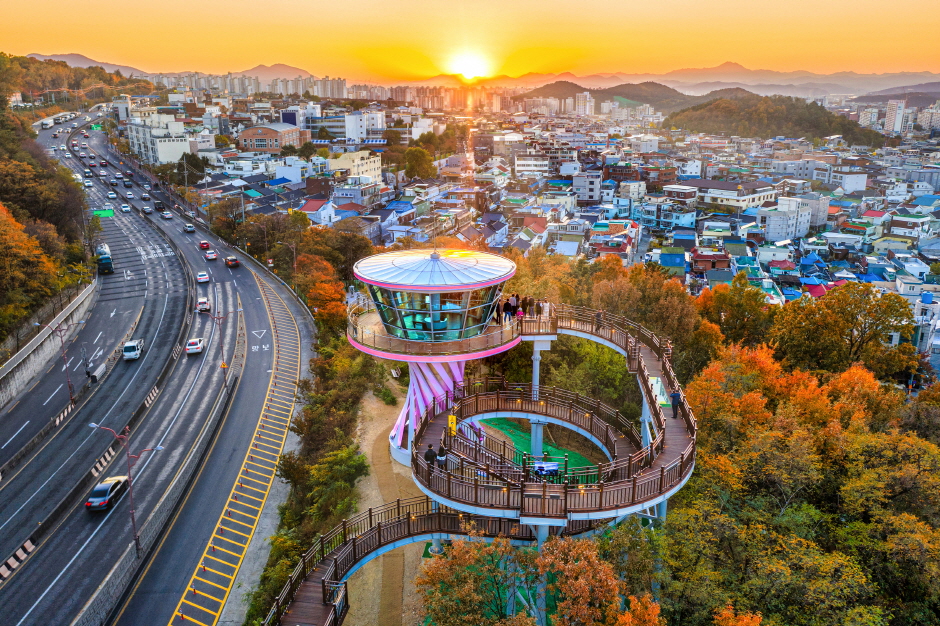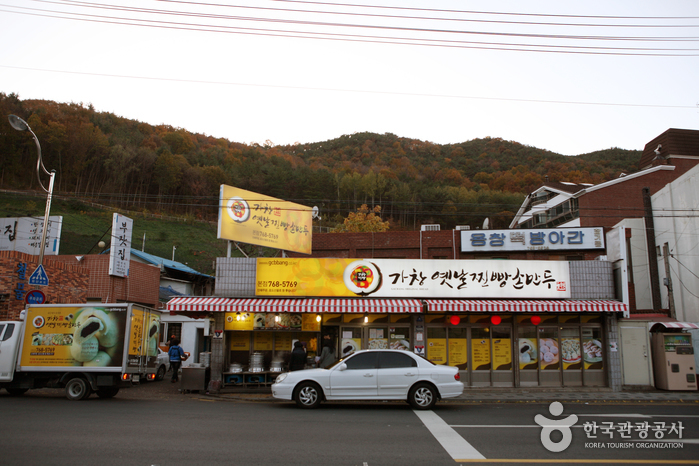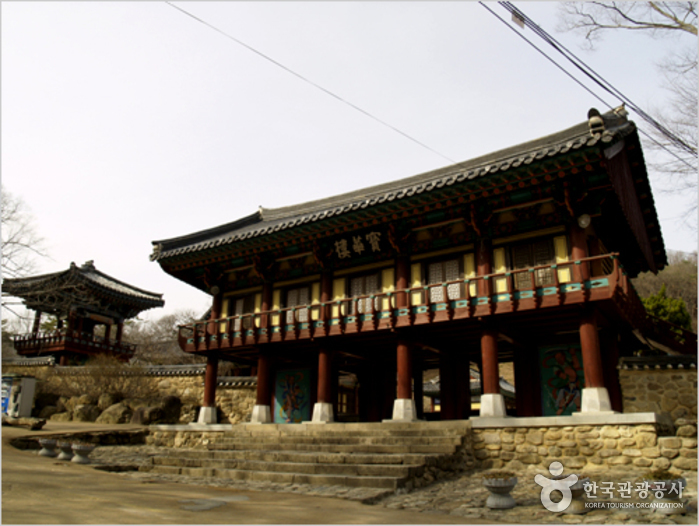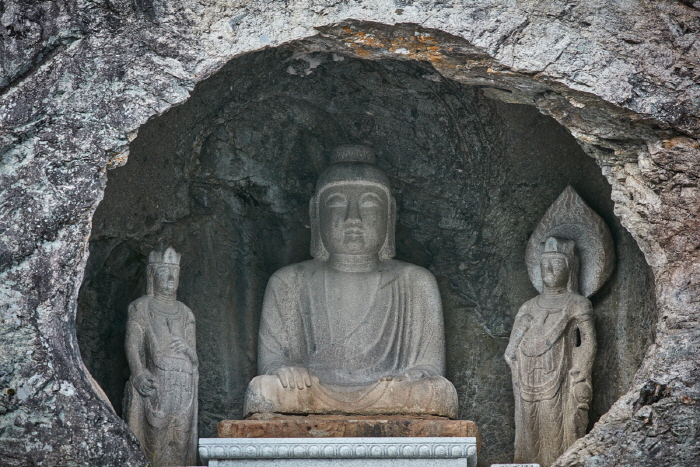Uniqlo - Daegu Gamsam Branch [Tax Refund Shop] (유니클로 대구감삼)
12.9Km 2024-04-23
1640, Dalgubeol-daero, Dalseo-gu, Daegu
-
Apsan Mountain Haeneomi Observatory (앞산 해넘이전망대)
13.1Km 2023-08-28
Daemyeong-dong, Nam-gu, Daegu
+82-53-664-2783
Apsan Mountain Haeneomi Observatory, where you can see the scenery of Daegu along with the sunset, is located in Apsan Ppallaeteo Park in Nam-gu. Incorporating the history and symbolism of Apsan Ppallaeteo Park, the observatory's design embodies laundry wring. The ramp leading to the observatory is perfect for walking as you can see the panoramic view of Apsan Mountain and the surrounding landscape.
Palgongsan National Park (Eunhaesa Temple Section) (팔공산국립공원 - 은해사지구)
13.2Km 2025-04-08
Geojo-gil, Yeongcheon-si, Gyeongsangbuk-do
+82-54-852-8031
Located east of Daegu downtown, Palgongsan Mountain (1,192.3m) was called both Jungaksan and Buaksan Mountain during the Silla period. The mountain has many ancient temples and historical sites such as the Gatbawi Stone Buddha, Wonhyosa Temple, Cheonseongsa Temple and Bulgulsa Temple.
Aritaum - Daegu Catholic Univ. Branch [Tax Refund Shop] (아리따움 대가대)
13.4Km 2024-04-18
1F, #103, 58, Hayang-ro, Hayang-eup, Gyeongsan-si, Gyeongsangbuk-do
-
Himart - Songhyeon Branch [Tax Refund Shop] (하이마트 송현점)
13.4Km 2024-04-18
244, Guma-ro, Dalseo-gu, Daegu
-
Park Jiyun's Gachang Jinbang (박지연의 가창옛날찐빵본점)
13.5Km 2024-02-27
1099 Gachang-ro, Gachang-myeon, Dalseong-gun, Daegu
053-768-5768
Gachang Original Bread, a renowned steamed bun bakery in Daegu, is celebrated for its jjinppang (steamed buns), a beloved traditional snack in Korea. This shop's success inspired the opening of other establishments selling steamed buns and dumplings in the area, eventually leading to the creation of Gachang Jjinppang Street. Since its opening in 2000, the bakery has committed to selling only buns made on the same day, meticulously kneaded and rolled by hand. Their flagship products, jjinppang and handmade mandu, have gained such popularity that they often attract long lines of customers.
Artbox - Gyeongsan Hayang-ro Branch [Tax Refund Shop] (아트박스 경산하양)
13.5Km 2024-04-22
87, Hayang-ro, Hayang-eup, Gyeongsan-si, Gyeongsangbuk-do
-
Yeongcheon Eunhaesa Temple (은해사 (영천))
13.7Km 2021-12-21
951, Cheongtong-ro, Yeongcheon-si, Gyeongsangbuk-do
+82-54-335-3318
Eunhaesa Temple, located on Palgongsan Mountain in Yeongcheon city, Gyeongsangbuk-do, is one of two major temples on the mountain along with Donghwasa Temple.
The temple was founded by Monk Hyecheol and was given the name Haeansa Temple in the first year of King Heondeok’s reign during the Silla Kingdom (AD 809), but was moved to the current site in the Joseon dynasty in 1546 (the first year of King Myeongjong). Upon its relocation, King Injong of Joseon dynasty was commemorated with a new lecture hall along with a memorial stone plaque where the king's umbilical cord was buried and sealed. It was then when the temple was also given its current name, Eunhaesa Temple.
The temple houses the main shrine, Bohwaru pavilion, Seolseondan Hall, Shimgeondang Hall, eight small hermitages, as well as Baegeungam Temple, Jungangam Temple, and a professional Buddhist education institution, the Eunhaesa Buddhist University. Eunhaesa Temple is home to a National Treasure, Geojoamyongsanjeon Hall, and Treasure, Baekheungamgeukrakjeon Hall. It also contains Treasure, the Sunidan Buddha Platform; Treasure, the Wunbuamcheongdongbosal Seated Buddha Statue; and Treasure, the Eunhaesa Temple Gwaebultaeng hanging Buddha picture. The area is also close to the Seongbu Museum, which exhibits cultural assets from Eunhaesa Temple and the neighboring areas, as well as popular tourist attractions such as Geukrakgul grotto of Jungangam temple (Hwaeomgul Grotto), Geondeul Rock, Manyeonsong Pine Tree, Ganggunsu Waters, and Anheungpokpo Falls of Gigiam Temple.
Olive Young - Daegu Gamsamdong Branch [Tax Refund Shop] (올리브영 대구감삼DI)
14.0Km 2024-04-18
130, Waryong-ro, Dalseo-gu, Daegu
-
Gunwi Buddha Triad Grotto (2nd Seokguram) (군위 아미타여래삼존 석굴)
14.5Km 2021-11-12
24, Namsan 4-gil, Gunwi-gun, Gyeongsangbuk-do
+82-54-383-8032
At the Hantijae Peak of Palgongsan Mountain in Daegu, is the Gunwi Buddha Triad Grotto, referred to as "the 2nd Seokguram Grotto". This grotto, designated as a National Treasure, is a natural cave on a sheer cliff. There is the beautiful Amitabul Buddha, the Bodhisattva of Power and the Bodhisattva of Compassion. The cave is 4.25 meters wide and 4.3 meters long, and is located 20 meters above the ground. This grotto is the progenitor of the Gyeongju Seokgulam Grotto, preceding the construction of Seokguram grotto by 100 years. It has been designated as a world cultural heritage.
The square-shaped ceiling is highest in the middle of the chamber. The Amitabul Buddha sits in the center with the Bodhisattva of Power and the Bodhisattva of Compassion flanking its left and right sides. The main Buddha is very refined and graceful with short hair and a divine smile on its face, sitting with crossed legs in a full-lotus posture.


![Aritaum - Daegu Catholic Univ. Branch [Tax Refund Shop] (아리따움 대가대)](http://tong.visitkorea.or.kr/cms/resource/56/2883756_image2_1.jpg)
![Himart - Songhyeon Branch [Tax Refund Shop] (하이마트 송현점)](http://tong.visitkorea.or.kr/cms/resource/16/2890016_image2_1.jpg)

![Artbox - Gyeongsan Hayang-ro Branch [Tax Refund Shop] (아트박스 경산하양)](http://tong.visitkorea.or.kr/cms/resource/51/2883751_image2_1.jpg)

![Olive Young - Daegu Gamsamdong Branch [Tax Refund Shop] (올리브영 대구감삼DI)](http://tong.visitkorea.or.kr/cms/resource/56/2884156_image2_1.jpg)

 English
English
 한국어
한국어 日本語
日本語 中文(简体)
中文(简体) Deutsch
Deutsch Français
Français Español
Español Русский
Русский